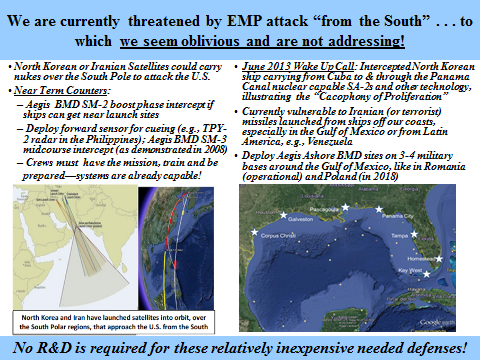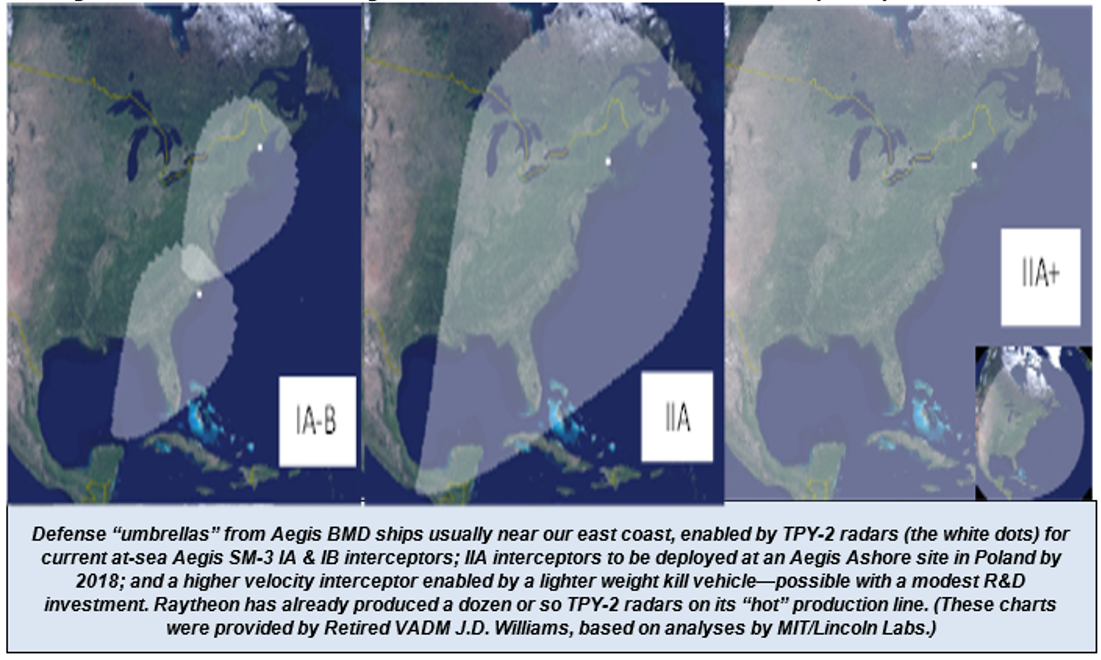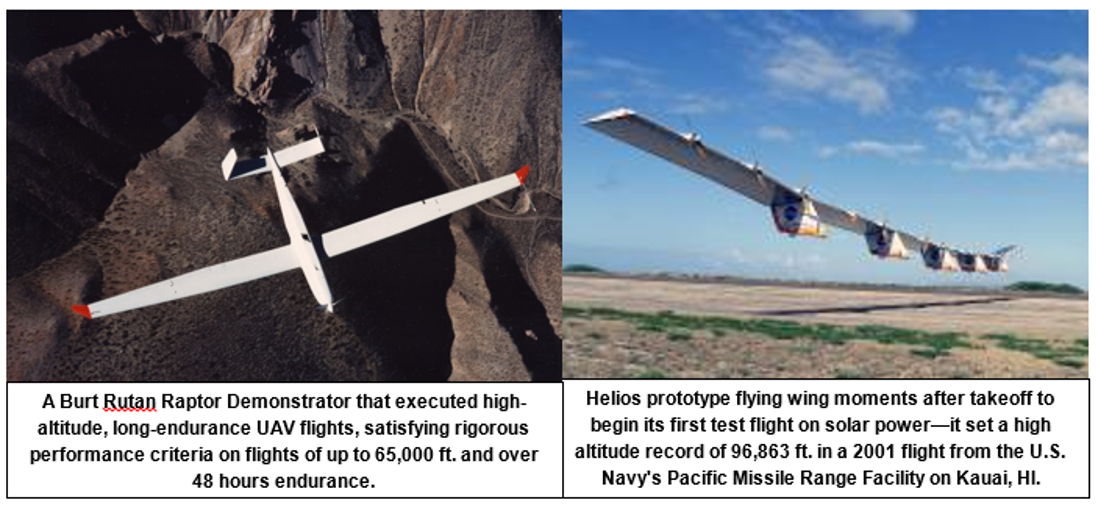“We propose to rebuild the key tools of missile defense, starting with the Navy cruisers that are the foundation of our missile defense capabilities in Europe, Asia and the Middle East. As we expand our Navy toward the goal of 350 ships, we will also procure additional modern destroyers that are designed to handle the missile defense mission in the coming years.” ~ Then Candidate Donald Trump, September 2016 in Philadelphia
With this quotation in mind and as we remember that yesterday was the 106th anniversary of President Ronald Reagan’s birth, I can’t help but emphasize his Strategic Defense Initiative (SDI) vision that was on target 34 years ago this coming March 23rd; was abandoned a decade later by the Clinton administration; and, after remaining dormant ever since, very much needs to be revived today.
If President Trump is to be true to his above promise from last September — especially rebuilding our ballistic missile defense (BMD) capabilities, then he should return to the Reagan SDI vision and “Win one for the Gipper,” Reagan’s famous “death bed” line from “Knute Rockne — All American.” Click here for a brief video of that scene from the 1940 film that stayed with Reagan throughout his career, and resonates today. See the signed photo below, which is still poignant given how the threats have grown since we lost our way a quarter century ago.
Consider the events in just the last couple of weeks. North Korea is again threatening another ballistic missile test, on its deliberate way to posing a direct intercontinental ballistic missile (ICBM) threat to U.S. cities. Last Friday during his Far East tour, Defense Secretary James Mantis warned North Korea of an “effective and overwhelming” U.S. response if Pyongyang chose to use nuclear weapons, as he reassured South Korea of steadfast U.S. support.
North Korea, which regularly threatens to destroy South Korea and the United States, conducted more than 20 missile tests last year, as well as two nuclear tests, in defiance of U.N. resolutions and sanctions. No doubt, the Great Leader will stay on his current course. Click here for a Newsweek article on SecDef’s recent trip to East Asia and related efforts to counter North Korea.
Then, over this past weekend, North Korea launched five surface-to-air missiles in a provocative exercise. It’s hard to miss the “message” and its associated test of the Trump administration.
Moreover, while Secretary Mantis was on his tour to the Far East, China launched a ballistic missile carrying 10 reentry vehicles — so-called Multiple Independently-targeted Reentry Vehicles (MIRVs). MIRVs were first developed by the United States and the Soviet Union in the 1960s during the Cold War to overcome early ballistic missile defense (BMD) systems.
China with MIRVs can easily overcome our present homeland BMD system. And the nature of proliferation includes that North Korea is often allied with China, and so is probably not be far behind in seeking such technology. It already has nuclear capabilities.
In this already dangerous context, Secretary Mantis and other Trump officials must pay attention to China’s provocations in the South China Sea and, above all else, not continue the Obama administration’s policies of appeasement and looking the other way.
China’s recent activity is no doubt a test to see if the Trump administration will continue President Obama’s dubious eight years of “leading from behind” policy.
Hopefully not, as President Trump has promised. Stay tuned.
All this is occurring in the context that our military leaders have recognized — and testified — for the past year or so, that we cannot afford just to build more BMD interceptors to respond to the growing ballistic missile threat. The cost of our current defense interceptors is too great to keep up with the cost of a proliferation of attacking nuclear armed ballistic missiles.
Not a new thought, the Gipper’s SDI program operated under a mandate that effective defenses must be survivable against direct attack and “cost-effective at the margin” — the so-called Nitze Criteria, contrary to the situation that has since evolved.
Moreover, the usual “cacophony of proliferation” can be expected to lead North Korea to export its key technologies, given its cash-starved situation and improving nuclear and ballistic missile capability.
Of particular concern are the Mullahs of Iran, now flush with money, thanks to the terrible Deal President Obama and Secretary of State Kerry negotiated, which released on the order of $150 billion in sanctions that had previously constrained Iran.
And, guess what? North Korea’s ally, Iran, tested another ballistic missile last week, in violation United Nations Resolutions and no doubt as a provocation to test President Trump’s response.
The unverifiable Deal does not provide constraints on these developments — and the immediate sanctions placed on Iran by President Trump, while certainly deserved, will do little to constrain Iran’s development activities, given the previous relaxation of sanctions imposed by our allies — this relaxation associated with the terrible Iran Deal.
Not surprisingly, Iran also continued its military exercises over the past weekend, threatening to attack their enemies with missiles. (Read especially the “Little Satan” Israel and the “Great Satan” United States.)
Furthermore, both North Korea and Iran have launched satellites to their south — such that they approach the United States from our south.
They could carry and detonate a nuclear warhead in space on their first pass over the United States, producing an electromagnetic pulse (EMP) that could blackout our electric grid for an indefinite period — resulting in the death of most Americans within a year, because of starvation, disease and societal collapse.
No development of reentry vehicles is required to pose this existential threat on all Americans. And as we have pointed out several times during the past four years, our defenses are sorely lacking against such this threat from the South.
For example, click here for a discussion of this threat and possible countermeasures that we could take, as are summarized in the below chart from my December 15, 2015 message, “A Big Week for Aegis BMD.”
The left side refers to the above mentioned satellite attack by either Iran or North Korea. On the right is summarized some implications of ballistic missile threats from the Gulf of Mexico, possibly even posed by terrorists.
This December 15, 2015 message came on the heels of the Navy’s first successful test of its new Standard Missile-3, Block IIA interceptor being jointly developed and tested with Japan. Not only is this interceptor to be deployed at sea, an “Aegis Ashore” version is also planned to be operational in 2018 in Poland.
Also provided was pertinent history of the Aegis BMD system, as well as its U.S. homeland defense possibilities, including in a ground-based configuration to defend against ballistic missiles that might be launched from vessels off our coasts, especially from the Gulf of Mexico.
To emphasize that this observation was not then a new idea, click here for my November 1, 2013 message that first pointed out these possibilities, as the ground was broken for our first Aegis Ashore site in Romania. Still, to my knowledge, after over three years, nothing has been funded to use this now well proven capability to defend Americans at home against ballistic missile attack from the Gulf of Mexico or from Central America, e.g., Venezuela.
Furthermore, as the “powers that be” consider how best to improve the defenses of those of us who live near the East Coast, I urge that they consider the below figure, from my July 29, 2014 message. Click here for that message entitled “Quick Fixes to Counter the Existential EMP Threat.”
The shaded regions in the above figure indicate the area that could be defended against ICBM attack from over the North Polar region, from Aegis BMD ships off our East Coast if sufficient tracking information is provided from appropriate forward based radars like the TYP-2 radars being deployed around the world, primarily to support our Theater Missile Defense (TMD) systems.
Currently, SM-3 Block IA and IB interceptors are deployed on up to 33 or so Aegis BMD ships at sea, and several are normally near or in port along our East Coast. If their crews were trained and ready, these Aegis BMD ships could defend the Eastern Seaboard with the aid of a couple of TPY-2 radars — one, say in Maine, and one, say on Camp Lejeune, North Carolina.
That so little, if anything, has been done to exploit this existing inherent capability is a testament to the lethargy in our defense programs to protect the American people, even as the development of the Aegis BMD system continues to progress in magnificent fashion — at least to defend our overseas troops, friends and allies.
Furthermore, note from the center picture in the above chart the major improvement in defense coverage offered by the Block IIA interceptor, now being tested for deployment at sea and in Romania. Late last week, the Navy and Japan jointly conducted a successful SM-3 Block IIA intercept at the Hawaii test range.
Thus, as indicated in the center picture above, only a single radar in Maine would enable Aegis ships along the East Coast, armed with Block IIA interceptors, to protect the United States out to the Great Lakes region against ICBM attacks that approach from over the North Polar regions.
Click here for the Navy’s public information report on that important successful test, which will provide greater U.S. and Japanese seafaring capability — and for Romania’s defense against Iranian ballistic missiles.
The SM-3 Block IIA could markedly improve the defense of those of us who live near our east coast against Iranian ICBMs that approach us from over the North Polar region — with little or no additional development cost. Last Friday’s successful test assures an impressive inherent defense coverage from the Navy’s Standard Missile, if carried on our usually off-shore BMD-capable Aegis cruisers and destroyers.
This capability could be further increased if the SM-3 Block II interceptor velocity is increased, as illustrated in the above “IIA+” figure (on the right), which illustrates how a lighter-weight kill vehicle would improve the defense footprint to cover most of the Continental United States. Worth a bit more R&D, you think?
Furthermore, we know how to build such a lighter weight kill vehicle to accomplish such an objective — we knew how a quarter century ago as part of President Reagan’s SDI program. This capability was pioneered in the Brilliant Pebbles program as discussed in several of my previous messages. Click here for my most recent (November 22, 2016) pertinent message, “Global Defense: First from the Sea, Then from Space.”
As I have argued many times, we ultimately want to develop a space based defense system that modernizes what first was advocated as Brilliant Pebbles, the most cost-effective defense concept developed during the SDI era — from 1984-1993. To be cost effective, those defensive space-based interceptors had to be light weight to keep the satellite launch costs down, and they had to carry an impressive lightweight sensor suite and computational capability to counter the offensive countermeasures that could be deployed against the Brilliant Pebbles constellation. These challenges could have been met in the early 1990s.
Although achieving this objective was possible during the SDI era, political opponents in congress demanded that the effort be curtailed — and the Clinton administration immediately gutted the SDI effort in early 1993, killing all Brilliant Pebbles activities and dispersing the technical experts that had pursued it.
Some key technologists sought to exploit those technologies to make Aegis BMD interceptors all they could be — specifically to achieve the IIA+ capability indicated in the above figure, but the George W. Bush administration “powers that be” gutted those efforts as well.
Hopefully, the Trump “powers that be” will revive these efforts as quickly as possible — to make Aegis BMD all it can be and to develop a modern Brilliant Pebbles space-based interceptor system as quickly as possible.
Click here for a pertinent critique, including a November 29, 2017 National Review article titled “How Trump Can Bring Back Reagan’s Defense Vision.” Among my co-authors was Ret. USA Lt. General Mal O’Neill, my SDI Deputy and subsequently the BMD acquisition executive who was compelled during those disastrous Clinton administration years — against his wishes I am certain — to gut the remnants of the Brilliant Pebbles effort. We both want to “Go back to the future!”
To do so would not only enable the most cost-effective BMD system conceived to date, it would also enable the “light weight” technology that could provide the Block IIA+ capabilities indicated in the above figure.
Furthermore, it could also enable another innovative cost-effective BMD concept, one developing light weight interceptors for deployment on unmanned aerial vehicles (UAVs) such as a modern version of the Raptor-Talon concept of the SDI era, illustrated below.
Click here for my May 29, 2014 message on this important concept and the potential for a revived version then advocated — without any notable effect on the then extant “powers that be.”
I would argue this challenge should be funded and issued to the Defense Advanced Research Projects Agency (DARPA), the Defense Department’s preeminent R&D organization — of course to be worked in close association with the Missile Defense Agency.
A modern Raptor-Talon development program could quickly be deployed on a crash basis without the political inhibitions that accompany space based interceptors — and it, like a SM-3 Block IIA+ interceptor for our Aegis BMD systems at sea and on land, could be rapidly developed in tandem without the bureaucratic and political burdens that would undoubtedly accompany a space-based interceptor system development program.
In so doing, I would argue that the Trump administration should seek to draw upon Ronald Reagan’s vision to develop all three ways — space-based, sea-based and UAV-based interceptors of SDI/Brilliant Pebbles heritage — to exploit today’s light weight modern Brilliant Pebble technology.
To “Win one for the Gipper!”
What can you do?
Join us in praying for our nation, and for a rebirth of the freedom sought, achieved and passed to us by those who came before us.
Help us to spread our message to the grass roots and to encourage all “powers that be” to provide for the common defense as they are sworn to do.
Begin by passing this message to your friends and suggest they visit our webpage www.highfrontier.org for more information. Also, please encourage your sphere of influence to sign up for our weekly e-newsletter.
Encourage them to review our past email messages, posted on www.highfrontier.org, to learn about many details related to the existential manmade and natural EMP threats and how we can protect America against them.
Click here to make a tax deductible gift. If you prefer to mail a check, Please send it to 500 North Washington Street, Alexandria, VA 22314.
E-Mail Message 170207
Please click here to read Past Weekly Updates!
Please help High Frontier continue this important and timely work!
Be sure to follow us on our Social Sites!
If you found this letter via our Social Sites, and you would like to subscribe, please click below!









